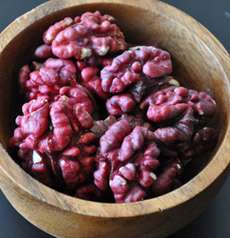PRODUCT: Red Walnuts
|
|
We’ve previously written about red celery, red watercress and sweet red corn, new varieties bred for their alluring color.
Now, you can add red walnuts to the list. The Sanguinetti family, farmers in California’s San Joaquin County, are growing a new and delicious variety of walnut: the red walnut. It has been named the Robert Livermore walnut in honor of a computer entrepreneur (1926-1997) and walnut grower who was interested in unusual varieties. First cross-bred in 1991 at U.C. Davis, the walnuts were selected for commercial growing by the breeding team in 1998. The new variety was patented in 2001. The walnuts are not genetically modified but were created using natural methods of grafting, in this case, grafting Persian red-skinned walnuts onto larger and creamier English walnuts. |
|
|
THE RED WALNUT TREE
The red walnut tree looks like any other walnut tree and the shell looks like any other walnut except for the bright burgundy red skin (skin) on the nut meat (kernel). The one key difference: It takes 8 to 10 years to produce a marketable crop instead of 1 to 3 years for conventional walnut trees—or 4 to 5 years if planted from seed. They continue to produce nuts for some 30 years. Varieties of “blood walnuts” have been found growning wild in Europe since the 18th century or earlier. But these varieties tend to bear fewer nuts and blotchy nuts; hence the cross-breeding to achieve the Robert Livermore. The delicious and healthful walnuts* are beautiful as snacks, on salads, in and on baked good and many other dishes. A bonus for those who don’t like the sharp tannins in some walnut varieties: Red walnuts are milder, with less “bite.” Red walnuts are late-producing, so are available at the end of fall until the end of the year. Because they are so rare, supplies are limited. *See the health benefits of walnuts. |
||
|
Walnuts have long been cultivated, with evidence dating back to about 7000 B.C.E. The species is native to the mountain ranges of Central Asia: western China, parts of Kazakhstan, Uzbekistan and southern Kirghizia to Nepal, Bhutan, Tibet, northern India and Pakistan, Afghanistan, Turkmenistan, Iran and portions of Azerbaijan, Armenia, Georgia and eastern Turkey. The Romans called walnuts Juglans regia, “Jupiter’s royal acorn,” which in modern taxonomy became the genus and species of the tree. In ancient Persia, walnuts were reserved for royalty. Thus, the walnut was often known as the Persian walnut. English merchant marines traded walnuts in ports around the world, and the nuts became known as English walnuts. (Walnuts were not grown commercially in England.) Walnuts were cultivated in California by the Franciscan fathers in the late 1700s, and were known as “mission” walnuts. By the 1870s modern walnut production had become a commercial enterprise. |
||
|
Today, California walnuts account for 99% of U.S. walnut production and 75% of the world’s walnuts. The annual harvest takes place in October. GET YOUR RED WALNUTS STORES: There are only a limited quantity of red walnuts from California. This year, they are being sold at retail in California, New York City/Metro (including Fresh Direct) and Texas. ONLINE: Order red walnuts online from ShaskyFarms.com. TREES: If walnut trees grow in your area, you can plant trees and harvest your own—in about eight years.
|
||



